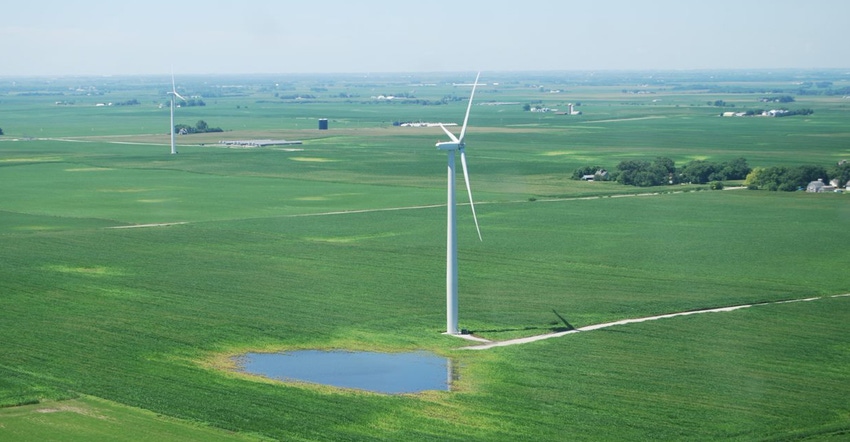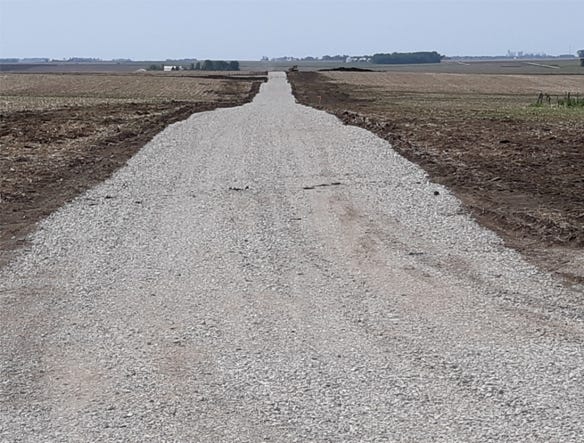July 17, 2019

By Loren G. Flaugh
Construction on what will be Cherokee County’s largest wind farm is progressing in Iowa. The 30,500-acre, 200-megawatt Glaciers Edge Wind Farm Project, located north of Marcus in northwest Iowa, is scheduled to be completed and on line by year-end.
In 2015, Darrell Downs, Marcus’ economic development director, and Mark Buschkamp, previous Cherokee area economic development director, began working to secure a large commercial-scale wind farm for Cherokee County. They met with or contacted several wind energy developers. They settled on EDF Renewables of San Diego to work with Marcus area landowners.
That June, Downs and Buschkamp mailed letters to landowners explaining their process for securing the right wind farm developer for landowners within the proposed project boundary. They had a vetting process and selected EDF.
At a subsequent meeting between EDF and residents, landowners’ concerns prompted EDF to revise their landowner lease contracts to accommodate the feedback. One critical landowner request was that all participants must be treated equally. They insisted no sweetheart deals be offered to anyone who signed a lease agreement early. EDF positioned a land agent, Derek Westenberg, and land acquisition manager, Curtis Nordick, to work in the area and talk to landowners.
Support from local community
At a June 2016 Cherokee County board of supervisors meeting, Downs introduced Chris Sternhagen, EDF Renewables development manager. Sternhagen said EDF was considering a 200-MW wind farm project with possibly as many as 100 turbine sites, and te Hhere was strong support from the local community.
Through the rest of 2016 and into 2017, landowner interest in signing EDF lease agreements continued to increase to the point where far more landowners wanted in on the project than the planned size of the proposed 30,500-acre wind farm. The Zoning Board of Adjustment discussed a $1,000-per-site conditional-use permit fee for 82 potential turbine sites and six alternate sites for an $88,000 total at an August 2018 public hearing. About 30 Marcus area residents, landowners and Cherokee County officials attended.
Numerous questions were raised. Some expressed concern the wind farm would not be allowed to connect to a nearby 345,000-volt MidAmerican Energy Co. transmission line. Some asked what the setback would be between a turbine site and a farmstead.
After a lengthy hearing, board member Lance Shafer made a motion to close the public hearing. Zoning administrator Dean Schmidt said EDF is just asking for a place to put wind turbines on farmland, and EDF followed the code and is looking for a conditional-use permit approval. Zoning board member Dale Glienke offered the motion to grant the permit. Board member Lee Foresman seconded. The vote was unanimous in favor of approving EDF’s permit request.

EASIER ACCESS: Low-profile access roads allow a farmer to drive across the road with a tractor and planter in the field. With no ditches, the access road is level with the farm field.

During a June 2019 session with Cherokee County auditor Kris Glienke and assessor Greg Zarr, the zoning board reviewed some of the early milestones related to the project. “We’re a little different in that Cherokee County has zoning that has all the authority to hold hearings for permit approval,” Glienke says. “We’ve not had a lot of public opposition that I’m aware of.”
At the board of adjustment’s public hearing, only a few people spoke in opposition to the project.
“All the way through the length of the project, the Cherokee County board of supervisors has strongly supported the project,” Glienke notes. “That’s because of the support from the area landowners. There’s much more land that people wanted included in the project than was needed.”
Zarr adds, “From the comments I’ve heard, more than a large percentage of the landowners involved in the project are very supportive of it.”
There were several hundred more acres that landowners wanted signed up than what the developer had turbine sites for. “It is the total opposite from what other counties have experienced,” Glienke says. “Ida County, for example, had a number of people openly against their wind farm.”
In Cherokee County, “landowners are, I think, very supportive because they can see the value of the tax base increase for the school district,” Glienke says. “They’ve done some great state-of-the-art development in the new industrial addition at Marcus. They worked with Northwest Iowa Community College on the program. They envision how this would really help the school district.” Zarr notes, “It was forward-thinking for the whole area.”
Glienke adds, “It could help young people here get job training to get them job-ready.”
Potential for property tax revenue
When this project was first discussed in June 2016, the board of supervisors had Speer Financial Inc. discuss the potential value of the project, taxation potential and whether the county might want to put part of the project in a Tax Increment Finance district to fund county road improvements. The supervisors decided not to use a TIF at this point.
Speer Financial anticipated the project’s net acquisition cost at $246 million, if 82 wind turbines were installed. Over a 20-year period, Speer also projected a total taxable value of $73 million for each year from 2028 to 2042. “I took Speer’s estimate and multiplied it by the current countywide levy rate and then estimated what the project would generate in property tax revenue over a 20-year period to 2042,” Glienke says. “That came to well over $10 million in property taxes paid into the county.�”
Glienke compared her figures with the current top four tax-paying entities in Cherokee County. When the wind farm is fully assessed at 30% in 2028, the property tax revenue could approach $588,690 per year through 2042. She says the Marcus ethanol plant, Little Sioux Corn Processors, currently pays a yearly property tax assessment of $280,668. Hy-Vee Food Stores Inc. has a yearly tax bill of $158,374. Two area Farmers Cooperatives have yearly tax bills slightly under that Hy-Vee figure.
Construction continues this summer
Wind farm construction progress in July includes turbine site access road surveying, road construction and turbine site concrete foundations are being poured. As of July 1, a majority of the 80 wind turbine foundations have been poured.
Where the 34,500-volt wind farm power collection cables cross under gravel and hard-surface roads, crews are busy boring under the roads and pulling a casing from one side to the other. Cable laying crews are burying cable across open farmland.
Earth moving machinery and dump trucks are reshaping gravel road intersections on the wind farm’s primary haul roads by making wide radius turns to accommodate the oversized wind turbine components soon to arrive. Crushed rock is being spread on these roads to beef them up for the extra heavy components.
One large crane has been assembled at the east end of the wind farm. Three more heavy-lift cranes will arrive on-site to meet the end-of-year deadline for EDF to begin operations. Turbine components have not yet begun to arrive, but those arrivals should begin soon.
The lease payments farmland owners receive from companies operating wind farms have generally increased over the years — another reason more landowners are willing to lease their land for turbines to be built. But the property tax revenue generated for use by local governments is also a consideration, as shown by this new Cherokee County wind farm project.
Flaugh writes from Primghar.
You May Also Like




